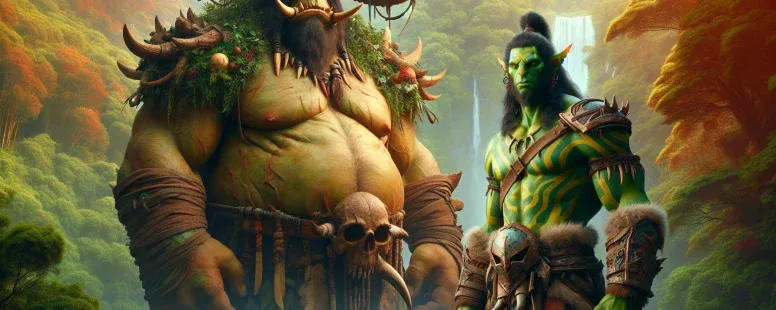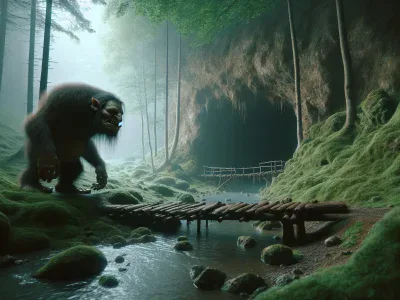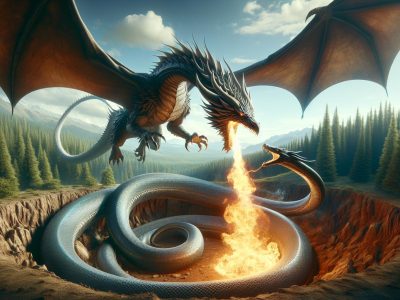Difference Between Ogre and Orc: Origins, Traits, and Cultural Representations Explained
Picture a misty forest where shadows loom large and the air hums with ancient tales. Among these stories, two fearsome creatures often emerge—ogres and orcs. But have you ever stopped to wonder what truly sets them apart? While both ignite imaginations in mythologies, fantasy novels, and epic games, their origins, traits, and roles couldn’t be more distinct.
As you jump into the rich worlds of folklore and fiction, understanding the differences between an ogre’s brute strength and an orc’s warrior spirit can deepen your appreciation for these legendary beings. Whether you’re crafting your own fantasy world or simply curious about their roots, unraveling this distinction will bring clarity to countless tales that feature these iconic figures.
Origins And Mythological Background
Ogres and orcs emerge from distinct cultural narratives, each rooted in unique mythologies. Their origins reveal how different societies imagined monstrous beings.
The Origins Of Ogres
Ogres originate from European folklore, particularly French mythology. The term “ogre” was first popularized by Charles Perrault in his 1697 tales, such as “Puss in Boots.” These creatures often symbolize gluttony and primal brutality, depicted as man-eating giants with grotesque features.
You find references to ogres across various cultures. In Norse mythology, Jötnar (giants) share similarities with ogres due to their immense size and ferocity. In Japan, oni—demonic entities—also resemble ogres in behavior and appearance but carry a supernatural element.
The perception of ogres shifted over time. Literature began portraying them less as pure villains and more as misunderstood outcasts. Stories like “Shrek” redefined the archetype for modern audiences.
The Origins Of Orcs
Orcs have roots in Old English mythology and literature. The term likely derives from the Latin “Orcus,” referring to an underworld deity associated with death. Early texts like Beowulf describe monstrous humanoids resembling orcs through figures like Grendel.
J.R.R Tolkien significantly shaped the modern concept of orcs in his Middle-earth legendarium during the 20th century. He characterized them as corrupted elves twisted by dark powers—a narrative absent from earlier myths.
Fantasy role-playing games further expanded on Tolkien’s vision of orcs. For example, Dungeons & Dragons introduced variations like half-orcs with complex backstories blending savagery and redemption themes into gameplay dynamics.
Unlike ogres tied primarily to folklore, orc depictions vary widely across media while retaining common traits: violent tendencies, group loyalty, and militaristic culture centered around conquest strategies rather than individual brute strength.
Physical Characteristics
Ogres and orcs differ significantly in physical attributes, contributing to their unique identities in folklore and fantasy settings.
Appearance Of Ogres
Ogres are typically depicted as massive humanoid creatures with exaggerated features. Their height often ranges from 8 to 12 feet, making them tower over humans. They possess broad shoulders, thick limbs, and a bulky frame symbolizing raw strength rather than agility. Their skin tones vary but are commonly portrayed in earthy shades like greenish-gray or brown. Features such as oversized heads, protruding jaws with sharp teeth, small eyes set deep into their skulls, and unkempt hair add to their intimidating presence.
You might notice ogres frequently carrying crude weapons like clubs or stone hammers, emphasizing their primal nature. In some depictions, they’re adorned with animal pelts or tattered clothing made from scavenged materials. These details reinforce their portrayal as brutish beings living on the fringes of civilization.
Appearance Of Orcs
Orcs appear slightly smaller than ogres but remain larger than an average human. They’re usually between 6 to 8 feet tall and exhibit muscular builds designed for combat. Unlike the rugged bulkiness of ogres, orcs have leaner frames that balance power with speed. Green skin is a hallmark feature in many versions of orc design (especially in modern fantasy), though shades can range from gray to reddish-brown depending on cultural interpretations.
Facial features include slanted eyes glowing red or yellow under shadowy brows and large tusks jutting upward from their lower jawline—a characteristic distinguishing them visually from humans. Orcs often wear tribal armor made of leather or scavenged metal pieces adorned with war paint or symbols representing their clan identity.
Cultural Representations
Cultural depictions of ogres and orcs reveal their evolving roles in storytelling, from ancient myths to modern media. These portrayals shape how you perceive their traits and interactions within different narratives.
Ogres In Folklore And Media
Ogres have deep roots in European folklore, symbolizing primal fears through tales of man-eating giants. French fairy tales like “Puss in Boots” show ogres as cruel yet cunning antagonists. Their monstrous appetite and towering size often embody greed and gluttony, making them a metaphor for excessiveness.
Modern media reshapes this image, softening their brutality into complex characters. For example, DreamWorks’ Shrek presents an ogre as a misunderstood antihero navigating prejudice with humor and heart. Such reinterpretations broaden your understanding of ogres beyond traditional villainy, showcasing themes of identity and acceptance.
Orcs In Folklore And Media
Orcs gained prominence through J.R.R Tolkien’s The Lord of the Rings, where they’re depicted as vile creatures bred for destruction. This portrayal influenced fantasy literature and games like Warcraft, which expanded on orc culture by introducing tribal hierarchies, honor codes, and internal conflicts.
Unlike ogres, orcs frequently represent militaristic societies driven by survival instincts rather than individual desires. These nuances let you explore questions about morality in war-driven narratives—are they inherently evil or shaped by circumstance? Modern adaptations even challenge stereotypes; for instance, some RPGs craft moral dilemmas around peaceful coexistence versus conflict with orc communities.
Behavioral Traits
Behavioral traits distinguish ogres and orcs not just in appearance but also in their actions, interactions, and roles within their respective narratives. Their tendencies reflect the cultural contexts from which they originate.
The Nature Of Ogres
Ogres exhibit solitary and instinct-driven behaviors. They often act as territorial predators, attacking intruders without hesitation. These creatures prioritize survival and indulgence, aligning with themes of gluttony from European folklore. You might encounter ogres portrayed as hoarders of food or wealth, driven more by impulse than strategy.
Even though their brutish nature, modern depictions have softened this image. In stories like “Shrek,” ogres display emotional depth and misunderstood intentions. This evolution offers a counter-narrative to traditional views of them as mindless antagonists.
The Nature Of Orcs
Orcs operate within structured social systems characterized by hierarchy and discipline. Unlike the loner tendencies of ogres, orc tribes emphasize unity for collective strength. Loyalty to clan leaders drives their militaristic culture, often depicted in battles against other factions or civilizations.
Their aggression stems less from random violence and more from survival instincts shaped by harsh environments. J.R.R Tolkien’s works highlight this through orcs bred as soldiers corrupted by dark powers—a narrative adapted widely across fantasy genres.
Modern portrayals sometimes challenge the “evil” stereotype of orcs by exploring internal conflicts within clans or individuals questioning their societal norms, adding nuance to these traditionally hostile figures’ behavioral complexities.
Key Differences At A Glance
Origins and Mythology
Ogres originate from European folklore, particularly French tales, where they’re depicted as man-eating giants embodying gluttony and savagery. Their mythos evolved through centuries into diverse interpretations. Orcs, on the other hand, emerged from Old English mythology with ties to the Latin term “Orcus,” associated with death and the underworld. Tolkien’s works redefined them as corrupted elves, cementing their role in modern fantasy.
Physical Traits
Ogres tower at heights of 8 to 12 feet with broad shoulders and exaggerated features like oversized jaws or bulbous noses. Their earthy skin tones range from gray to muddy brown. Orcs are smaller but still imposing at 6 to 8 feet tall, sporting muscular builds and greenish skin tones. They have slanted eyes, prominent tusks, and tribal armor that signify their clan identity.
Behavioral Patterns
Ogres lead solitary lives driven by primal instincts such as hoarding food or guarding territory fiercely. They’re often portrayed as brutish yet misunderstood beings in modern narratives. Orcs thrive in structured social systems led by clan leaders; they prioritize loyalty and unity while balancing aggression for survival in hostile environments.
| Feature | Ogres | Orcs |
|---|---|---|
| Height | 8-12 feet | 6-8 feet |
| Skin Tone | Earthy (gray/brown) | Green |
| Behavior | Solitary/Instinct-driven | Clan-based/Hierarchical |
| Origins | European Folklore | Old English Mythology |
Conclusion
Exploring the distinctions between ogres and orcs opens a deeper appreciation for their roles in folklore and fantasy. These creatures, shaped by unique origins and cultural influences, reflect timeless themes of strength, survival, and identity. Whether you’re drawn to the brute force of ogres or the disciplined ferocity of orcs, understanding their individual characteristics enriches your experience of their stories.
Their evolving portrayals in modern media remind you that even mythical beings can carry complex narratives. By diving into these differences, you uncover not only their legendary past but also the creative possibilities they inspire today.
- Understanding the Difference Between Oath and Affirmation: Key Facts You Need to Know - October 30, 2025
- Understanding the Difference Between Annulled and Divorced: Key Legal and Emotional Insights - October 30, 2025
- Ibuprofen vs. Aspirin: A Comprehensive Comparison - October 30, 2025






